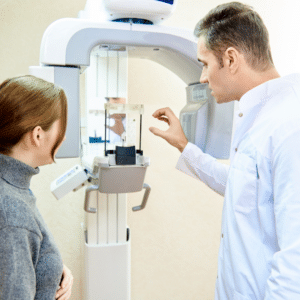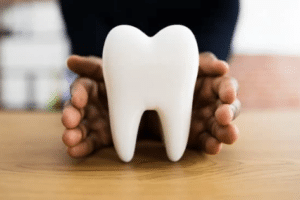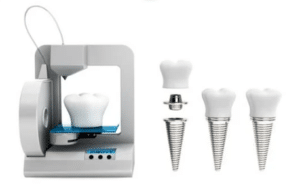The Role of Technology in Dental Implant Procedures
In the ever-evolving landscape of healthcare, technology is an undeniable game-changer. Dentistry, as a field, has seen significant transformations in recent years, and one of the most notable areas where technology has left its mark is dental implant procedures. These innovations have revolutionized the precision and effectiveness of dental implants and elevated the overall patient experience. In this extensive guide, we will delve deep into how technology plays a pivotal role in dental implant procedures.
1. Digital Imaging and Diagnostics
- Cone Beam Computed Tomography (CBCT)
The cornerstone of successful dental implant procedures lies in accurate diagnosis and precise treatment planning. This is where digital imaging technology has stepped in, specifically  Cone Beam Computed Tomography (CBCT).
Cone Beam Computed Tomography (CBCT).
Cone Beam Computed Tomography (CBCT): CBCT technology is akin to traditional CT scans but tailored for dental use. It provides highly detailed 3D images of a patient's oral anatomy, encompassing the teeth, jaws, and surrounding structures. This level of precision is unparalleled, allowing dental professionals to assess bone density, locate vital structures, and plan implant placement with absolute accuracy.
- Intraoral Scanners
Gone are the days of messy, uncomfortable impression materials. Modern dental implant procedures now employ intraoral scanners, a marvel of digital dentistry. These handheld devices capture digital impressions of a patient's mouth, creating a virtual model that can be used for various purposes, including implant planning and the design and fabrication of custom implant restorations. Patients benefit from a more comfortable and efficient process, while dental professionals gain access to highly accurate digital data that aids in achieving a perfect fit for implant restorations.
2. Computer-Aided Design and Manufacturing (CAD/CAM)
In the realm of dental implants, precision is paramount. CAD/CAM technology has proven to be a game-changer, revolutionizing the design and fabrication of dental implants and restorations.
- Custom Abutments and Crowns
Dental professionals can now harness CAD/CAM technology to design custom abutments and crowns, tailored to each patient's unique oral anatomy. These components are essential for the success of dental implants. Customization ensures a snug fit and optimal function of the implant restoration. CAD/CAM technology allows for the creation of restorations that look and feel natural and offer long-term durability.
- Guided Implant Surgery
Implant placement is a critical phase of the procedure, and precision here is non-negotiable. CAD/CAM technology has introduced guided implant surgery, a technique that minimizes the margin for error. This technology enables the creation of surgical guides based on the digital data obtained from CBCT scans and intraoral impressions. These guides dictate implant placement's exact position, angle, and depth. The result is a minimally invasive approach that reduces the risk of complications and significantly shortens patient recovery times. Guided implant surgery is particularly beneficial for complex cases involving multiple implants or compromised anatomical conditions.
3. Robotics in Implant Surgery
Emerging on the horizon of dental implant procedures is the integration of robotic-assisted surgery, a development that promises enhanced precision and safety.
- Improved Precision
Robotic systems are designed to carry out implant placement with remarkable precision. They are programmed to follow the treatment plan to the minimum detail, minimizing the risk of errors that can impact the long-term success of the implant. This level of precision is particularly beneficial in challenging cases where there may be limited bone or compromised  anatomical structures.
anatomical structures.
- Enhanced Safety
Safety is paramount in any surgical procedure, and robotic systems come equipped with advanced safety mechanisms. These systems can detect unexpected movements or deviations from the planned path and immediately make adjustments to prevent damage to adjacent structures or vital anatomical features. This level of control ensures a safer surgical experience for patients.
4. Teledentistry and Patient Education
The role of technology extends beyond the confines of the dental clinic; it has also facilitated patient education and communication.
- Virtual Consultations
Teledentistry, a branch of telehealth, has gained prominence, allowing patients to consult with dental professionals remotely. Through video calls and secure online platforms, patients can discuss treatment options, address concerns, and receive guidance before the actual procedure. This is particularly valuable for patients living in remote areas or having mobility limitations.
- Animated Visuals
The power of visualization cannot be overstated, especially when it comes to dental implant procedures. Technology has made it possible for patients to gain a clear understanding of the procedure through animations and 3D models. These visual aids help patients visualize each step of the process, from initial consultation to the final restoration, leading to better-informed decisions and reduced anxiety.
5. Post-Operative Monitoring
The benefits of technology in dental implant procedures continue into the postoperative phase.
- Digital Records
Electronic health records (EHRs), including dentistry, have become standard in healthcare. In the context of dental implant procedures, EHRs streamline record-keeping and patient management. Dentists can easily access a patient's treatment history, making tracking progress and ensuring timely follow-ups easier.
- Remote Monitoring
Implant patients can now benefit from remote monitoring, a cutting-edge application of technology that enhances post-operative care. Some dental implants are equipped with sensors that can transmit data to a remote monitoring system. This data includes information on bite force, temperature, and other factors related to implant health. Dental professionals can monitor this data and intervene proactively if any issues arise. This real-time monitoring ensures the early detection of potential complications and contributes to the long-term success of dental implants.
6. Future Innovations
As technology continues to advance at an astonishing pace, the future of dental implant procedures holds even more promise. Here are a couple of exciting innovations on the horizon:
- 3D Printing of Implants
 Advancements in 3D printing technology are poised to revolutionize implantology. Researchers are exploring possibly being able to fabricate patient-specific implants directly in the dental office. This innovation could streamline manufacturing and reduce production times significantly. Patients could potentially have their implants created on-site, eliminating the need for off-site fabrication. This could be particularly advantageous in cases where immediate implant placement is desirable.
Advancements in 3D printing technology are poised to revolutionize implantology. Researchers are exploring possibly being able to fabricate patient-specific implants directly in the dental office. This innovation could streamline manufacturing and reduce production times significantly. Patients could potentially have their implants created on-site, eliminating the need for off-site fabrication. This could be particularly advantageous in cases where immediate implant placement is desirable.
- AI-Powered Diagnosis
Artificial intelligence (AI) has already made significant inroads into healthcare, and dentistry is no exception. AI-powered diagnostic tools are being developed to aid in the assessment of dental conditions and predict implant success rates. AI algorithms can analyze a patient's unique oral and medical history, along with data from CBCT scans and other diagnostic tools, to provide insights into the likelihood of implant success. This predictive capability can help both patients and dental professionals make informed decisions regarding treatment options.
Conclusion
In conclusion, technology has firmly established itself as a cornerstone in the world of dental implant procedures. Its impact is evident at every stage, from precise diagnosis and treatment planning to the surgical phase and post-operative care. As technology continues to advance, we can only expect further innovations that will enhance the success rates of dental implants, reduce patient discomfort, and ensure the longevity of these vital dental interventions. The future of dental implantology is indeed a promising one, driven by the relentless pursuit of excellence in patient care and outcomes through the integration of cutting-edge technology. Stay tuned for the latest updates in this exciting field! Contact us today!
Ready to find out more?
Contact us for more information!
